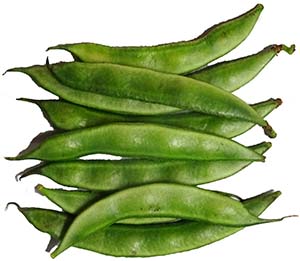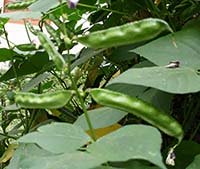Hyacinth bean (Lablab) Nutrition facts
The hyacinth bean, also known as the lablab bean, is a cultivar of pole beans within the Fabaceae family of legumes.
Originating possibly in Indian subcontinent, it is commonly cultivated in home-gardens for its immature pods, which are consumed as vegetables. Additionally, these beans are appreciated in Japan ("fujimame (フジマメ)," ) as well as in the Middle East, Central America, and Brazil.
Botanically, these beans are classified under the vine (twining) variety within the Fabaceae family, specifically the genus Lablab.
Scientific name: Lablab purpureus.
Hyacinth are also referred by various names such as dolichos bean, seim bean (सेम फली), Egyptian bean, bonavist bean/pea, dolico lablab, fagiolo indiano, among others.
 |
| Hyacinth (Lablab) beans. |
The lablab bean, a variety of annual Dolichos beans, is closely related to black-eyed peas and yard-long beans. The hyacinth plant, a tropical twining perennial, requires a trellis for support and can thrive as a short-term perennial under favorable moisture and climatic conditions.
Clusters of purple or white flowers develop into flat, thick, slightly curved green pods with pointed ends. Each pod usually contains two to six seeds, round or oval in shape, with colors varying from light green to cream, black, brown, or mottled, and featuring a distinct white hilum covering about one-third of the seed.
Fresh, immature lablab beans are harvested and consumed whole, with the pod and skin being edible, much like green beans. The dried beans, on the other hand, serve as an excellent substitute for other legumes in a variety of recipes.
Health Benefits of Hyacinth (Lablab) Beans
Raw hyacinth pods contain only 46 calories per 100 grams (3.5 oz), while dry mature seeds provide a higher energy value of 344 calories.
Dry hyacinth beans offer 23.90 g of protein per 100 grams, contributing to 44% of the recommended daily allowance (RDA).
Fresh as well as dry lablab beans are an excellent source of dietary fiber among pole beans, providing 25.6 g (64% DV) per 100 grams. Fiber functions as a bulk laxative, protecting the colon mucosa by reducing exposure to toxins and binding cancer-causing compounds in the colon.
Research shows that dietary fiber helps lower blood cholesterol by reducing the reabsorption of bile acids in the colon.
Hyacinth beans are naturally gluten-free and serve as a healthy alternative for those with gluten intolerance or celiac disease.
Dry hyacinth beans are rich in several B-complex vitamins — including thiamin, pyridoxine, riboflavin, pantothenic acid, folates, and niacin — which act as co-factors in carbohydrate, protein, and fat metabolism.
They contain 1.130 mg of thiamin (94% DV), which plays a vital role in carbohydrate metabolism. Thiamin deficiency can result in Beriberi disease.
Fresh, immature hyacinth pods are rich in vitamins A and K, providing 864 IU (29% DV) of vitamin A per 100 grams. Vitamin A acts as a potent antioxidant supporting mucosal repair and maintenance.
Fresh pods also supply vitamin C, offering 12.6 mg (21% DV) per 100 grams. Vitamin C promotes wound healing and tissue repair while acting as a strong antioxidant.
Dry lablab beans are packed with essential minerals — providing copper (148% DV), calcium (13%), iron (64%), magnesium (71%), manganese (68%), phosphorus (53%), and zinc (84%) per 100 grams.
Additionally, 100 grams of beans deliver 1235 mg (26% DV) of potassium, a key electrolyte that maintains cellular balance and counteracts the harmful effects of sodium on heart health and blood pressure.
| Principle | Nutrient Value | Percent of RDA |
|---|---|---|
| Energy | 344 Kcal | 17% |
| Carbohydrates | 60.74 g | 47% |
| Protein | 23.90 g | 43% |
| Total Fat | 1.69 g | 8.5% |
| Cholesterol | 0 mg | 0% |
| Dietary Fiber | 25.6 g | 67% |
| Vitamins | ||
| Folates | 23 μg | 6% |
| Niacin | 1.610 mg | 10% |
| Pyridoxine | 0.155 mg | 12% |
| Riboflavin | 0.136 mg | 10% |
| Thiamin | 1.130 mg | 94% |
| Vitamin A | 0 IU | 0% |
| Electrolytes | ||
| Sodium | 21 mg | 1.5% |
| Potassium | 1235 mg | 26% |
| Minerals | ||
| Calcium | 130 mg | 13% |
| Copper | 1.335 mg | 148% |
| Iron | 5.10 mg | 64% |
| Magnesium | 283 mg | 71% |
| Manganese | 1.573 mg | 68% |
| Phosphorus | 0.372 mg | 53% |
| Selenium | 8.2 μg | 15% |
| Zinc | 9.30 mg | 84% |
Selection and storage
 |
| Lablab purpureus. |
In many Asian households, tender and immature lablab beans are widely used in everyday cooking. Fresh beans are easily available in local markets across tropical regions, making them a common ingredient in traditional dishes.
Choose fresh, tender, and immature beans for the best flavor and texture. Avoid beans that are shriveled, broken, cut, or bruised, as they tend to spoil quickly and lose quality. For longer freshness, store them in the refrigerator just like French beans.
Preparation and Serving Methods
Begin by rinsing the beans thoroughly under cold running water to remove any dirt or debris. Trim the ends and remove any strings that come off easily. Then cut the beans into uniform pieces to ensure even cooking.
When using dry beans, soak them in cold water for 6–8 hours before boiling. This process helps reduce anti-nutritional compounds and minimizes the likelihood of flatulence.
Consider these serving suggestions:
Use fresh beans in stir-fries, stews, baked dishes, or salads for added nutrition and flavor.
In India, hyacinth beans are known as seim beans (सेम फली). Tender beans are used in the popular dish sem-aloo ki sabzi, prepared with potatoes, onions, and tomatoes.
Che dau van is a traditional Vietnamese dessert made from boiled hyacinth beans, sugar, and coconut milk.
In Kannada, the whole immature pods are called Chapparada avarekayi (ಚಪ್ಪರದ ಅವರೆಕಾಯಿ) — meaning trellised lablab pole beans — used to make a flavorful curry often served over rice.
Safety Profile
Always ensure hyacinth beans are thoroughly cooked before consumption. Raw beans contain cyanogenic glycosides, which can release cyanide gas and cause toxicity.
Proper cooking destroys these harmful substances, making the beans safe and nutritious to eat. (Medical disclaimer).
You may also like to read≻≻-
Green beans Nutrition facts and Health benefits.
Adzuki beans Nutrition facts and Health benefits.
Chickpeas Nutrition facts and Health benefits.
Lima beans Nutrition facts and Health benefits.
fava beans Nutrition facts and Health benefits.
≻≻-Back to Legumes from Hyacinth bean. Visit here for an impressive list of vegetables with complete illustrations of their nutrition facts and health benefits.
≻≻-Back to Home page.
Further Resources:
Hyacinth mature seeds-USDA National Nutrient Database.
Raw, immature pods-USDA National Nutrient Database.